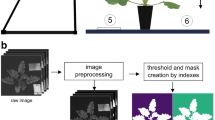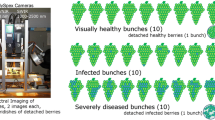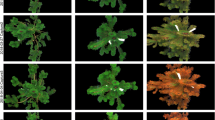Abstract
Pine wilt disease caused by a forest-invasive alien species, the pine wood nematode (Bursaphelenchus xylophilus) is considered as one of the most destructive pest problems. In recent years, spectroscopic technologies have shown great potentials for the assessment of forest damage due to their nondestructive, noninvasive, cost-effective, and rapidly responsive nature. This paper first identified the hyperspectral characteristics of pine wilt disease by measuring and analyzing the changes in spectral reflectance of healthy and infected Pinus massoniana trees. Then 16 spectral features were extracted from the spectral bands covering the green region (510~580 nm), the red region (620~680 nm), the red edge (680~760 nm), the near-infrared region (780~1100 nm), and coded as genes composing the chromosome of a genetic algorithm (GA). Based on the optimal spectral features with suitable fitness from the GA, a partial least squares regression (PLSR) prediction model was built with highest determination coefficient R2c = 0.91, R2v = 0.82, relative prediction deviation RPD = 3.3 and lowest root mean square error RMSEc = 0.23, RMSEv = 0.33 on the calibration and validation datasets. Compared with other PLSR models, our proposed GA-based approach significantly improves the prediction accuracy with few input spectral features.






Similar content being viewed by others
References
Abu-Kalaf N, Salman M (2014) Visible/near infrared(VIS/NIR) spectroscopy and multivariate data analysis (MVDA) for identification and quantification of olive leaf spot (OLS) disease. Palest Tech Univ Res J 2:(1):1–8
Bolón-Canedo V, Alonso-Betanzos A (2018) Recent advances in ensembles for feature selection. Springer, Berlin, Heidelberg
Carnegie AJ, Venn T, Lawson S, Nagel M, Wardlaw T, Cameron N, Last I (2018) An analysis of pest risk and potential economic impact of pine wilt disease to Pinus plantations in Australia. Aust For 81(1):24–36
Cheng T, Riaño D, Ustin SL (2014) Detecting diurnal and seasonal variation in canopy water content of nut tree orchards from airborne imaging spectroscopy data using continuous wavelet analysis. Remote Sens Environ 143:39–53
Coops N, Stanford M, Old K, Dudzinski M, Culvenor D, Stone C (2003) Assessment of Dothistroma needle blight of Pinus radiata using airborne hyperspectral imagery. Phytopathology 93(12):1524–1532
Duan F, Yang S, Huang D, Hu Y, Wu Z, Zhou W (2014) Craniofacial reconstruction based on multi-linear subspace analysis. Multimed Tools Appl 73(2):809–823
Guo T, Han L, He L, Yang X (2014) A GA-based feature selection and parameter optimization for linear support higher-order tensor machine. Neurocomputing 144:408–416
Hernández-Clemente R, Navarro-Cerrillo RM, Suárez L, Morales F, Zarco-Tejada PJ (2011) Assessing structural effects on PRI for stress detection in conifer forests. Remote Sens Environ 115(9):2360–2375
Holland JH (1992) Adaptation in natural and artificial systems: an introductory analysis with applications to biology, control, and artificial intelligence. MIT, Cambridge
Huang M, Gong J, Li S, Zhang B, Huang X (2012) Study on pine wilt disease hyper-spectral time series and sensitive features. Remote Sens Technol Applic 27(6):954–960
Hyun MW, Kim JH, Suh DY, Lee SK, Kim SH (2007) Fungi isolated from pine wood nematode, its vector Japanese pine sawyer, and the nematode-infected Japanese black pine wood in Korea. Mycobiology 35(3):159–161
Ju Y, Pan J, Wang X, Zhang H (2014) Detection of Bursaphelenchus xylophilus infection in Pinus massoniana from hyperspectral data. Nematology 16(10):1197–1207
Kim SR, Lee WK, Lim CH, Kim M, Kafatos MC, Lee SH, Lee SS (2018) Hyperspectral analysis of pine wilt disease to determine an optimal detection index. Forests 9(3):115–127
Kwon TS, Shin JH, Lim JH, Kim YK, Lee EJ (2011) Management of pine wilt disease in Korea through preventative silvicultural control. For Ecol Manag 261(3):562–569
Larsolle A, Muhammed HH (2007) Measuring crop status using multivariate analysis of hyperspectral field reflectance with application to disease severity and plant density. Precis Agric 8(1–2):37–47
Li S, Wu H, Wan D, Zhu J (2011) An effective feature selection method for hyperspectral image classification based on genetic algorithm and support vector machine. Knowl-Based Syst 24(1):40–48
Liu J (2013) Spectral features analysis of Pinus massoniana with pest of dendrolimus punctatus walker and levels detection. Spectrosc Spectr Anal 33(2):428–433
Lu J, Zhao T, Zhang Y (2008) Feature selection based-on genetic algorithm for image annotation[J]. Knowl-Based Syst 21(8):887–891
Luther JE, Franklin SE, Hudak J, Meades JP (1997) Forecasting the susceptibility and vulnerability of balsam fir stands to insect defoliation with Landsat thematic mapper data. Remote Sens Environ 59(1):77–91
Mota MM, Braasch H, Bravo MA, Penas AC, Burgermeister W, Metge K, Sousa E (1999) First report of Bursaphelenchus xylophilus in Portugal and in Europe. Nematology 1(7):727–734
Mutanga O, Skidmore AK, Prins HHT (2004) Predicting in situ pasture quality in the Kruger National Park, South Africa, using continuum-removed absorption features. Remote Sens Environ 89(3):393–408
Van Nguyen T, Park YS, Jeoung CS, Choi WI, Kim YK, Jung IH, Chon TS (2017) Spatially explicit model applied to pine wilt disease dispersal based on host plant infestation. Ecol Model 353:54–62.
Nijat K, Shi Q, Wang J, Rukeya S, Ilyas N, Gulnur I (2017) Estimation of spring wheat chlorophyll content based on hyperspectral features and PLSR model. Trans Chin Soc Agric Eng 33(22):208–216
Ren WY, Dan WU, Qin L (2016) Preliminary study on data collecting and processing of unmanned airship low altitude hyperspectral remote sensing. Ecol Environ Monit Three Gorges 1:52–57
Sankaran S, Mishra A, Maja JM, Ehsani R (2011) Visible-near infrared spectroscopy for detection of Huanglongbing in citrus orchards. Comput Electron Agric 77(2):127–134
Shi Z, Wang Q, Peng J, Ji W, Liu H, Li X, Rossel RAV (2014) Development of a national VNIR soil-spectral library for soil classification and prediction of organic matter concentrations. Sci Chin Earth Sci 57(7):1671–1680
Sousa E, Naves P, Vieira M (2013) Prevention of pine wilt disease induced by Bursaphelenchus xylophilus and Monochamus galloprovincialis by trunk injection of emamectin benzoate. Phytoparasitica 41(2):143–148
Suzuki K (2002) Pine wilt disease-a threat to pine forest in Europe. Dendrobiology 48:71–74
Wang Z, Zhang XL, An SJ (2007) Spectral characteristics analysis of Pinus Massoniana suffered by Bursaphelenchus Xylophilus. Remote Sens Technol Applic 22(3):367–370
Wang Z, Shao YH, Wu TR (2013) A GA-based model selection for smooth twin parametric-margin support vector machine. Pattern Recogn 46(8):2267–2277
Wang J, Cui L, Gao W, Shi T, Chen Y, Gao Y (2014) Prediction of low heavy metal concentrations in agricultural soils using visible and near-infrared reflectance spectroscopy. Geoderma 216(4):1–9
White JC, Coops NC, Hilker T, Wulder MA, Carroll AL (2007) Detecting mountain pine beetle red attack damage with EO-1 Hyperion moisture indices. Int J Remote Sens 28(10):2111–2121
Wu N, Liu J, Yan R, Zhou G (2012) Using spectral feature parameters to estimate the chlorophyll content of Chinese fir under disease stress. Plant Prot 38(4):72–76
Wu J, Gao Z, Liu Q, Li Z, Zhong B (2018) Methods for sandy land detection based on multispectral remote sensing data. Geoderma 316:89–99
Zhang T (2011) Changes of reflectance spectra of pine needles in different stage after being infected by pine wood nematode. Spectrosc Spectr Anal 31(5):1352–1356
Zhang S, Qin J, Tang X, Wan Y, Huang J, Song Q, Min J (2019) Spectral characteristics and evaluation model of Pinus Massoniana suffering from Bursaphelenchus xylophilus disease. Spectrosc Spectr Anal 39(3):865–872
Zhu Z, Li J, Guo Y, Cheng X, Tang Y, Guo L, Li X, Lu Y, Zeng X (2018) Accuracy improvement of boron by molecular emission with a genetic algorithm and partial least squares regression model in laser-induced breakdown spectroscopy 2018. J Anal At Spectrom 33(2):205–209
Acknowledgements
This research was funded by National Natural Science Foundation of China, grant number 61601060, China Scholarship Council Foundation, grant number 201709955001, Chongqing Science and technology commission Foundation, grant number cstc2016jcyjA0437, Chongqing Municipal Education Commission Foundation, grant number KJZH17132 and Defense science and Technology Bureau, grant number 32-Y20A18-9001-15-17-3.
Author information
Authors and Affiliations
Corresponding author
Additional information
Publisher’s note
Springer Nature remains neutral with regard to jurisdictional claims in published maps and institutional affiliations.
Rights and permissions
About this article
Cite this article
Zhang, S., Huang, J., Hanan, J. et al. A hyperspectral GA-PLSR model for prediction of pine wilt disease. Multimed Tools Appl 79, 16645–16661 (2020). https://doi.org/10.1007/s11042-019-07976-5
Received:
Revised:
Accepted:
Published:
Issue Date:
DOI: https://doi.org/10.1007/s11042-019-07976-5




